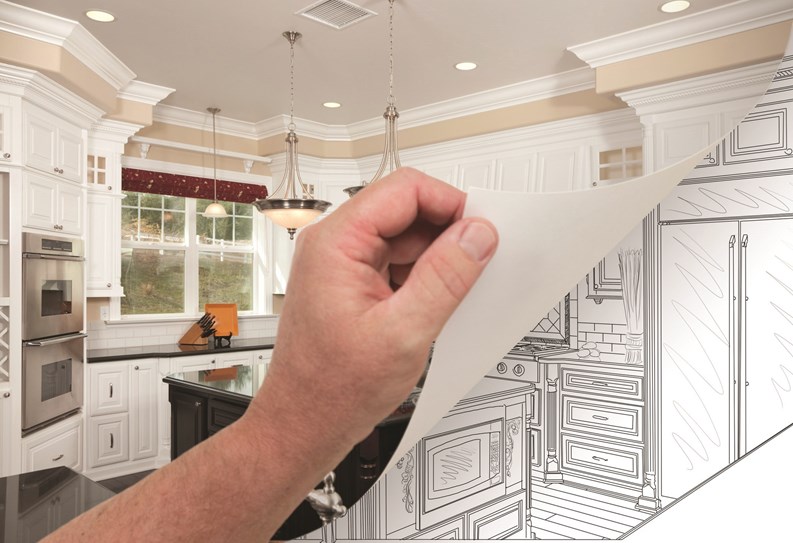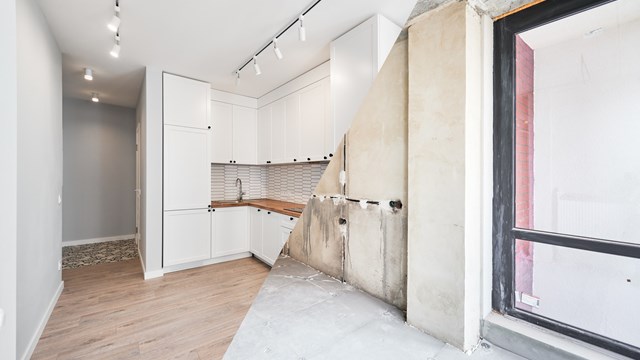Peter and Sarah have three boys, all under the age of six. While that fact sinks in, consider this: all three boys shared a single bedroom in the family’s modest, two-bedroom condo. When the tots were small, this set-up worked well, and Peter and Sarah enjoyed their bedroom to themselves, just down the hall. But once their eldest son turned six, things changed.
“It was like the flip of a switch, he just sort of got cramped. He couldn’t articulate the problem, but we knew he needed a place for himself, somewhere he would have space for his books and just a little more breathing room,” says Sarah. So, Peter and Sarah did the truly selfless thing: they let the big brother move into their room, and they moved their room into the office off the living room. There was plenty of square footage in the office, and the room actually gets more light in the mornings. The problem? No doors. “Yeah, we are going to have to figure that out,” saidys Peter. “I won’t be okay with temporary doors,” said Sarah. “We’ll have to install pocket doors, it looks like, because the room doesn’t allow for regular doors, and they can’t hinge out because there isn’t enough room for them to open.”
The Challenge of Change
Peter and Sarah’s challenge is change, and change, as they say, is inevitable. At some point, every board will have to deal with a shareholder or unit owner’s request to remodel or redesign their space. Maybe it’s a new owner who is super into feng shui and needs to rearrange things to better facilitate a positive flow of chi. Maybe an owner has purchased the neighboring unit and intends to knock down a couple of walls to make one big super-unit. Or maybe an owner is like Peter and Sarah: their family has grown and changed, and their space needs to change with them.
While these modifications and alterations are being considered by the resident, condo boards and homeowner associations must consider what those changes mean to the building as a whole, how alterations should be regulated and structured, and how they may impact other residents.
Rather than waiting until an owner comes asking, legal and management pros strongly advise putting into place a policy in your association’s rules and regulations that will protect your building and also help guide residents as they navigate what walls to – or not to —knock down. Kelly C. Elmore, principal attorney at Kovitz Shifrin Nesbit in Chicago, suggests a construction policy or alteration agreement that spells out the procedure for any owner who wants to undertake construction or a modification project in their unit.
As Elmore explains, getting things n record is vitally important, as is recognizing the scope of a given project. “The rules may also include a form for the owner to fill out, detailing the project information,” Elmore says. “For smaller projects that require only a painter or a small type of repair or renovation, the association may only require written notice and proof of the contractor’s insurance. For larger projects that will result in work being performed in or near the common elements, many associations require a full set of plans and project specifications from the owner in order to allow the association’s engineer or architect to review them.”
Elmore notes that in the case of a larger project, an association may want to include in their policy provisions mandating that the unit owner obtain the board’s consent prior to inception of the project, which may only be granted after the association’s professional has had an opportunity to review and approve the project.
Crystal Clear Communication
Clarity of language and board or association agreement, understanding and compliance will help you enforce your community’s alteration policies. Fairness and universal enforcement is also absolutely crucial. Carolyn Caste and Michael Joseffer, senior project manager and director of construction operations, respectively, both of Howard L. Zimmerman Architects, PC in New York City note that any type of alteration policy needs to apply to all owners in the building. “Establishing which alterations to the apartments are allowed and which are not and enforcing those equally, regardless of if it is a board member’s apartment or a celebrity’s, or any other factor,” says Caste.
According to Joseffer, “One of the really sticky situations that we as the reviewing architect sometimes find ourselves in is the issue of code versus alteration rules.” In other words, while an alternation may be allowed by municipal building codes, the policy or alteration agreement may prohibit it. Joseffer offers an example: “There is nothing in the code that prohibits ‘wet-over-dry’ – the expansion of a ‘wet’ area, like a kitchen or bathroom, over a ‘dry’ area, like a living room or bedroom – however, many building alteration rules prohibit it. If the board decides to allow [such an alteration] to appease a fellow board member, then a precedent has been set that can result in the argument that ‘If they could do it, then why can’t I?’, which sometimes leads to legal actions.”
Boards are always juggling numerous aspects of a building’s health and wellness, so while they might not be thrilled to have every alteration under their roof be made their business, it might be wise to make sure nothing is being done without at least some awareness by the board. As Caste cautions, “All alterations, no matter how minor they seem, should be reviewed by the building’s architect. Many times, a relatively minor alteration may affect the waterproofing or structural, electrical or plumbing elements of the building.” You also might find that these routine reviews uncover larger projects that absolutely require more oversight. “Some owners claim they are only changing the cabinets,” says Caste, “but instead file for a complete gut renovation, which was not properly reviewed.”
Elmore agrees, pointing out that board awareness and board consent are two different things. “Generally, for repairs that do not involve the common elements, or will not affect the structural integrity of the building, notice to the board will suffice. However, where a project may threaten the structural integrity of the building and/or common elements, or where a project may affect neighboring units, then board consent should be required.”
Controlling the Chaos
As anyone who has ever taken on a remodeling or rehabilitation project—big or small—knows, it usually takes longer than expected and is a little messier than you’d like it to be. After a project has been properly vetted and approved, management of the project begins, and there are neighbors to consider—neighbors who don’t have any problems with their cabinets and didn’t ask to deal with the noise, dust, and general disruption that comes with construction carried out in close quarters.
The key to avoiding angry residents lies, again, in that policy document. “Set construction hours in the rules and regulations to avoid a disturbance to other residents,” advises Elmore. “In larger buildings where a freight elevator is requested for use by an owner’s contractor, the board and management can use the reservation of the elevator as a means to ensure that proper hours are being followed.” Caste suggests that typical work hours are 8 a.m. to 5 p.m., with noisy work occurring from 9 a.m. to 4 p.m. on weekdays only.
Your policy document can be a catch-all for a number of things you want to keep tightly controlled, including how far in advance of a project that the board requires notice from the owner of their intentions to make an alteration. On this item, Elmore suggests that the amount of advance notice can be based on the scope of the project. “In cases where only notice to the board or management is required, five to 10 days may be sufficient. For larger projects, ample time and notice must be provided to the board to allow the board to consult with an engineering or architectural professional.”
Even if an owner provides an airtight proposal, crossing all their t’s and dotting all their i’s, a board can still turn down or deny an alteration proposal, because while apartments are private property, Caste explains, “The apartments are a share of a whole property, and the overall management and upkeep of the property is ultimately up to the entity and the board that manages it.”
That is an important thing to keep in mind, because things can get complicated. A board may find itself dealing with damage to a common area or adjacent apartments caused by a resident’s alterations, and as Caste and Joseffer point out, the cost of any such repairs should be charged to the unit owner. Additionally, if and when construction does not progress in a timely matter, boards need to step in and investigate. The stronger a building’s policy is, the less they will struggle with the challenges of change within their building.
In Peter and Sarah’s home, everyone is enjoying the new arrangement. “I’ve gotten used to the change of space, and our kids are so much happier,” says Sarah. “I haven’t loved our privacy coming from a sheet hanging in the office door, but that will change soon, too.” Peter and Sarah have gotten their permissions: two pocket doors will be installed later this year.
Rebecca Fons is a freelance writer and a frequent contributor to The Cooperator.







Leave a Comment